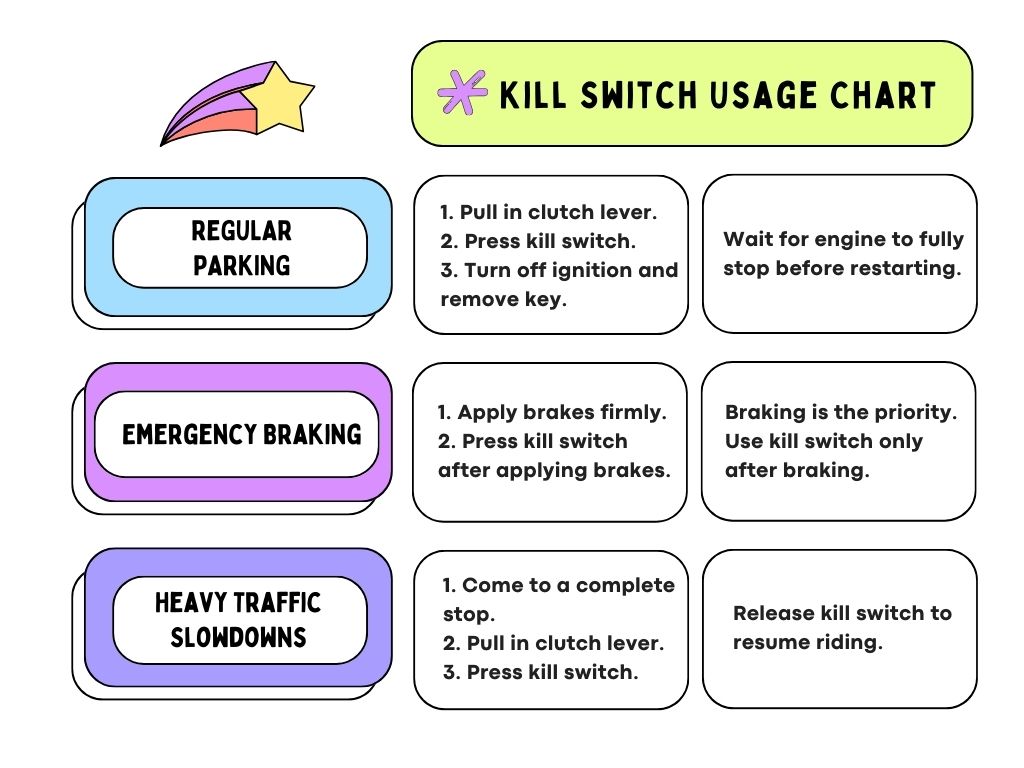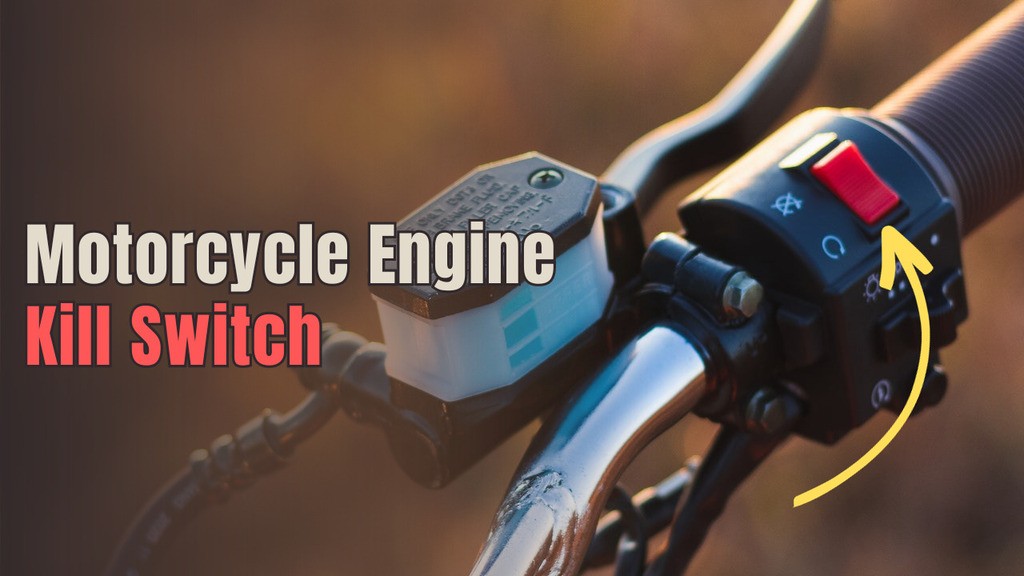Ever wonder about that red button on your motorcycle’s handlebars? It’s not just there for decoration – it’s the kill switch, a crucial safety feature that every rider should be familiar with.
The button lets you instantly shut down your engine, potentially saving the day in an emergency situation. But there’s more yo should know about the kill switch to stay safe while riding.
Let’s learn everything you need to know about using this essential tool like a pro!
Key Takeaways
- The engine cut off switch (kill switch) instantly stops ignition spark and engine function, allowing for emergency shutdown.
- Know how to use it correctly – pull in the clutch, push/flip the switch, wait for engine to fully stop before restarting.
- Refer to your owner’s manual for manufacturer guidance specific to your motorcycle model. Usage policies vary.
- When engaged properly, it has no harmful effects on battery, components, or the engine itself over regular use.
Motorcycle Engine Cut Off Switch Explained
The little red button on the bike’s handlebar is an important safety feature.
Most riders know it as the “kill switch,” since that pretty much sums up its job of killing the engine. You might also hear it called the “emergency stop switch” or “engine cut out switch.”
So in terms of appearance, it’s usually a red button or lever mounted on the right handlebar, within easy thumb’s reach. This lets you turn off the engine without taking a hand off the bars.
How to Use the Kill Switch
I remember the first time I had to use a kill switch in a real emergency. It was my third month of riding and I was cruising along a country road when a deer jumped out in front of me.
When I slammed on the brakes, the front end started wobbling like crazy. No way was I keeping that bike under control!
Instinct kicked in and my thumb jabbed that kill switch without even thinking. The engine cut instantly and I was able to wrestle the bike safely to a stop, heart pounding. That moment really drove home why they put these switches on bikes.
SEE MORE: The Surprising Science Behind Motorcycle Engine Weight Distribution
Between traffic stops, parking lots, and who-knows-what surprises might come your way down the road, it pays to be familiar with your kill switch.
The Functions of a Kill Switch
How exactly does this little button do its job? Let me break down the technical side.
At its most basic, the kill switch works by interrupting the electrical circuit that sends power to your ignition coil. It generates the spark to make the engine run. When you hit that switch, it cuts the coil off from power.
Now I know what you’re thinking – what’s an ignition coil has to do with anything? Bear with me here.
The coil takes the low-voltage current from your bike’s battery and boosts it way up to tens of thousands of volts. This super-charged zap is what sends a spark across the spark plug gap to ignite the fuel/air mixture in the cylinder.
No spark = no combustion = engine off.
On newer bikes, something called the capacitor discharge ignition (CDI) unit does the spark-making job. It works like the coil’s assistant.
Either way, when you flip the kill switch, it interrupts the pathway these components use to reach the spark plug. No more spark means the engine stops functioning.
The cool part is how quick and simple this makes turning your engine on and off. No fumbling for keys required. Just flick your thumb while keeping a grip on the bars.
Proper Usage of the Motorcycle Engine Cut Out Switch
So, what’s the right time to push that little red button? Let’s go over some proper shutoff techniques.

1. Regular Parking:
- Pull in the clutch lever with your left hand. This disconnects the engine from the wheel, preventing it from trying to move the bike forward when you shut it down.
- With the clutch held in, press the kill switch with your right thumb. The engine will sputter and stop.
- Now, you can safely turn off the ignition and remove the key.
2. Emergency Braking:
- If you need to slam on the brakes in an unexpected situation, don’t forget the kill switch!
- While braking firmly with both hands, quickly press the kill switch with your thumb. This prevents the engine from revving too high as you slow down, reducing wear and tear on the engine and potentially improving your control.
- Remember, braking should always be your primary focus in an emergency. Only use the kill switch after applying the brakes.
3. Heavy Traffic Slowdowns:
- Stuck in crawling traffic? Instead of constantly holding the clutch in to prevent stalling, use the kill switch!
- Come to a complete stop, pull in the clutch, and then press the kill switch. This lets you relax your hand while waiting for traffic to move without worrying about the engine stalling.
- When it’s time to go, simply release the kill switch, and you’re off!
Bonus Tip: Always wait for the engine to fully stop before restarting, especially after using the kill switch in an emergency situation. This ensures a smooth and safe restart.
Potential Issues From Misusing the Kill Switch
the kill switch is your friend, but like any tool, it’s important to use it correctly. Here are some key practices to keep in mind:
Master the sequence: Get comfortable with the golden rule:
Clutch in, kill switch, then engine off.
This ensures a smooth shutdown and prevents unnecessary wear on your motorcycle.
Avoid the mash: Tapping the kill switch once is enough. Repeatedly pressing it won’t stop the engine any faster and could put unnecessary strain on the electrical system.
Remember to turn it back on: It might sound obvious, but in the heat of the moment, forgetting to flip the kill switch back to “on” will neutralize the electric starter. Develop the habit of double-checking the switch before attempting to restart.
Stay off the switch while riding: The kill switch is for emergencies and stopping, not for attempting to control engine speed while riding. Using it at speed can lead to a loss of control, so keep your fingers off it unless you need to come to a complete stop.
Minor offenses, but they can still cause frustrations like a no-start or potentially hazardous situations. Just remember – kill switch is for stopping, not messing with idling motors or riding.
SEE MORE: Motorcycle Engine Keeps Cutting Out: Reasons and Fixes
Conclusion
While we’ve covered the general guidelines for using your kill switch, it’s important to remember that your motorcycle’s specific manual is the ultimate authority.
Different manufacturers might have slightly varying recommendations, so take a few minutes to consult your manual for any specific instructions related to your motorcycle model.
They may offer insights on situations where the kill switch is particularly useful or circumstances where it’s best to use the ignition key instead.
Remember, your manual is your best friend when it comes to understanding your motorcycle’s unique quirks and ensuring its smooth operation.
SEE MORE: What Is CC In Bike Engine and How it Impacts Ride’s Performance?
FAQs About Motorcycle Engine Cut Off Switch
Can my kill switch malfunction?
Yes, like any electrical component, it can wear out. Signs include difficulty turning off the engine or the engine not staying off. Have it checked by a mechanic if you suspect an issue.
Does the kill switch work if my battery dies?
No, the kill switch relies on battery power. If your battery is completely dead, the switch won’t cut the ignition circuit. That’s why it’s always smart to also turn the ignition key when stopping the engine.
Will a kill switch work on an electric motorcycle?
Yes, most electric motorcycles have kill switches that cut off power to the motor for safety.
Does engine braking work after using the kill switch?
On most bikes, yes. The engine still acts as a brake even if the kill switch cuts the spark.
Does a motorcycle cut off switch work without the key being on?
No, the kill switch relies on the ignition circuit being powered by the ignition key. If the key is off, the kill switch has no power to operate and interrupt the ignition system.




